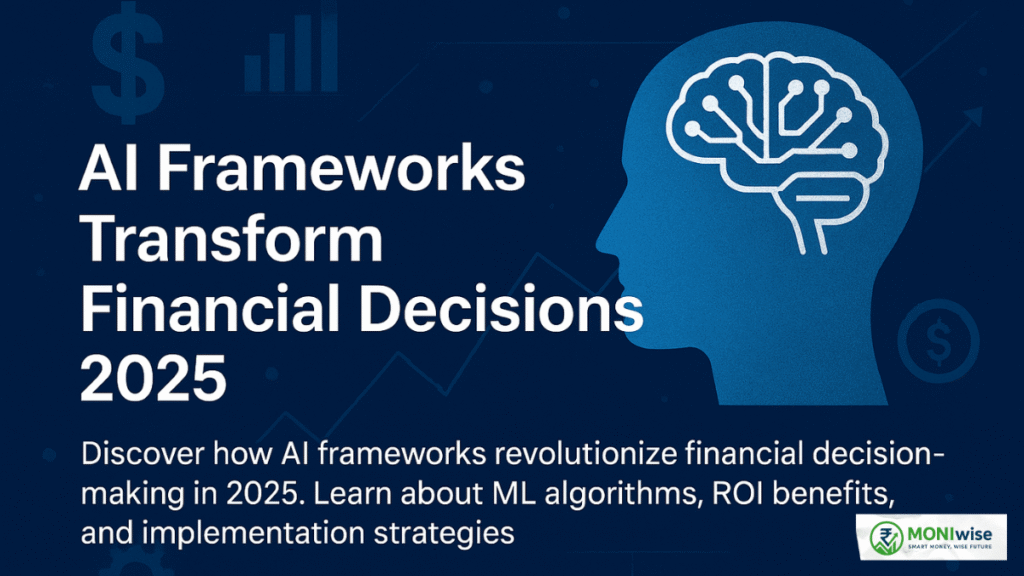In 2025, artificial intelligence frameworks are fundamentally transforming how financial institutions make critical business decisions. With the global AI in finance market projected to reach $190.33 billion by 2030, these frameworks are no longer experimental tools but essential infrastructure driving the future of financial services.
The Revolutionary Impact of AI Frameworks on Modern Finance
What Are AI Frameworks in Financial Decision-Making?
AI frameworks in financial decision-making encompass integrated systems of machine learning algorithms, predictive analytics, and automated decision-support tools that process vast amounts of financial data to generate actionable insights. These frameworks combine multiple AI technologies including:
- Machine Learning (ML) algorithms for pattern recognition and predictive modeling
- Deep learning networks for complex data analysis and risk assessment
- Natural Language Processing (NLP) for sentiment analysis and document processing
- Reinforcement learning for algorithmic trading and portfolio optimization
Core Technologies Driving Financial AI Transformation
Machine Learning Algorithms Reshaping Finance
Machine learning has emerged as the backbone of modern financial decision-making systems. According to industry research, 91% of asset managers are using or plan to use AI for portfolio construction and research—a sharp increase from 55% in 2023.
Key ML Applications in Finance:
- Predictive Analytics: ML models analyze historical market data and economic indicators to forecast price movements with 95% accuracy
- Credit Scoring: Advanced algorithms analyze alternative data sources beyond traditional metrics, expanding credit access while reducing default rates by 10-20%
- Risk Assessment: ML frameworks identify hidden correlations in data that might elude human analysis, enabling early detection of potential financial risks
Deep Learning and Neural Networks
Deep learning technologies are revolutionizing complex financial tasks that were previously impossible to automate. These systems excel at:
- Processing unstructured data from news articles, social media, and financial reports
- Identifying subtle patterns in market behavior
- Enhancing fraud detection capabilities with real-time analysis
Natural Language Processing in Finance
NLP technologies are transforming how financial institutions process and understand textual data. In 2025, these systems can:
- Analyze thousands of earnings call transcripts and broker reports daily
- Extract insights from regulatory documents for compliance monitoring
- Generate automated financial reports with human-like accuracy
Revolutionary Applications of AI Frameworks
1. Automated Trading and Investment Strategies
AI-powered algorithmic trading systems now execute trades in milliseconds, responding to market fluctuations faster than any human trader. These systems:
- Analyze vast market datasets including news sentiment and economic indicators
- Deliver returns 15% higher than traditional trading methods
- Process real-time data to optimize trading strategies continuously
2. Enhanced Risk Management
Modern AI frameworks provide unprecedented capabilities for financial risk assessment:
- Real-time monitoring of market conditions and portfolio performance
- Stress testing capabilities that simulate extreme market conditions not present in historical data
- Credit risk modeling using synthetic borrower profiles to improve accuracy
3. Personalized Financial Planning
AI frameworks enable hyper-personalized financial services by:
- Analyzing individual customer data to craft bespoke financial plans
- Providing automated budget adjustments and investment rebalancing
- Offering 24/7 financial guidance through AI-powered robo-advisors
4. Fraud Detection and Prevention
Financial institutions leveraging AI frameworks report:
- 30% reduction in fraud losses through real-time anomaly detection
- $10.4 billion in global cost savings from AI-led fraud detection by 2027
- Proactive identification of suspicious activities before they become losses
Quantifiable Benefits and ROI of AI Implementation
Cost Savings and Operational Efficiency
The financial impact of AI frameworks is substantial and measurable:
- Operational Cost Reduction: Banks can save $900 million by 2028 through AI automation
- Processing Efficiency: AI reduces case resolution time by 45% while improving customer retention by 35%
- Resource Optimization: Automated processes free up human resources for higher-value strategic activities
Revenue Growth Opportunities
AI frameworks don't just reduce costs—they actively drive revenue growth:
- Personalized Services: AI-driven customization increases revenue potential by $1.2 trillion in banking by 2035
- Enhanced Decision-Making: 70% of financial services executives believe AI will directly contribute to revenue growth
- New Product Development: AI enables innovative financial products and services tailored to customer needs
Performance Metrics and Success Indicators
Organizations implementing AI frameworks report:
- 57% of leaders say ROI is exceeding their expectations
- 20-30% increases in loan approval rates with 10-20% reductions in default rates
- Improved accuracy in predictive analysis with enhanced operational efficiency
Implementation Challenges and Solutions
1. Data Quality and Governance
Challenge: Poor data quality remains a significant barrier to AI success, with messy, siloed, and outdated information hampering AI performance.
Solution:
- Establish robust data governance frameworks
- Implement data lakes to consolidate disparate sources
- Utilize advanced data cleaning tools and preprocessing techniques
2. Regulatory Compliance and Transparency
Challenge: Financial institutions must navigate complex regulatory frameworks while implementing AI solutions.
Solution:
- Adopt Explainable AI (XAI) techniques for transparency
- Develop comprehensive AI governance structures
- Engage actively with regulatory authorities for compliance guidance
3. Talent Shortage and Skill Gaps
Challenge: 62% of banks report moderate to severe shortages of AI talent.
Solution:
- Invest in upskilling programs for existing employees
- Partner with educational institutions for talent pipeline development
- Build cross-functional teams combining domain experts with AI specialists
4. Legacy System Integration
Challenge: Integrating AI solutions with existing banking infrastructure presents technical difficulties.
Solution:
- Modernize core banking systems to facilitate AI integration
- Implement cloud-native, composable technology stacks
- Adopt API-first architectures for seamless integration
Future Trends and Emerging Technologies
Generative AI in Financial Services
Generative AI is reshaping financial services through:
- Document Processing: Automated analysis and summarization of financial documents
- Content Generation: Creating personalized financial reports and investment recommendations
- Decision Support: Generating multiple scenario analyses for strategic planning
Agentic AI and Autonomous Decision-Making
By 2025, financial institutions are implementing agentic AI systems capable of:
- Making autonomous decisions with minimal human intervention
- Continuously learning from interactions to improve performance
- Acting as intelligent financial assistants for both institutions and customers
Real-Time Data Processing
The shift toward real-time analytics enables:
- Instant fraud detection and response
- Dynamic portfolio rebalancing based on market conditions
- Immediate risk assessment and mitigation strategies
Best Practices for AI Framework Implementation
1. Strategic Planning and Assessment
- Conduct comprehensive AI readiness assessments
- Define clear objectives and success metrics
- Develop phased implementation strategies
2. Technology Selection and Integration
- Choose AI frameworks that align with business objectives
- Ensure compatibility with existing systems
- Prioritize scalable and flexible solutions
3. Risk Management and Governance
- Implement robust AI governance frameworks
- Establish continuous monitoring and validation processes
- Develop ethical AI guidelines and compliance procedures
4. Training and Change Management
- Invest in comprehensive employee training programs
- Foster a culture of AI adoption and innovation
- Provide ongoing support and development opportunities
Industry Case Studies and Success Stories
Wells Fargo's Predictive Banking
Wells Fargo implemented AI-powered predictive banking features that provide personalized insights through 50+ prompts related to account activity. This AI framework enhances customer experience while improving financial decision-making capabilities.
HSBC's Investment Analytics
HSBC leverages AI to boost predictive analytics for identifying high-growth stocks. Their AI framework combines market data analysis with predictive modeling to enhance investment strategies.
BlackRock's Risk Management
BlackRock analyzes over 5,000 earnings call transcripts quarterly and 6,000 broker reports daily using AI frameworks. This enables advanced risk management and data-driven investment decisions.
Measuring Success: Key Performance Indicators
Financial Metrics
- Return on Investment (ROI) from AI implementations
- Cost savings from automated processes
- Revenue growth from new AI-enabled services
- Operational efficiency improvements
Operational Metrics
- Processing time reductions
- Error rate decreases
- Customer satisfaction improvements
- Compliance adherence rates
Strategic Metrics
- Market share growth
- Innovation capability enhancement
- Competitive advantage development
- Long-term sustainability indicators
Conclusion: The Future of AI-Driven Financial Decisions
AI frameworks are not just transforming financial decision-making—they're revolutionizing the entire financial services landscape. With the AI in financial planning and wealth management market expected to reach $129.6 billion by 2034, organizations that embrace these technologies today will lead tomorrow's financial ecosystem.
The evidence is clear: AI frameworks deliver measurable ROI through cost savings, efficiency gains, and revenue growth. However, success requires strategic implementation, proper governance, and continuous adaptation to emerging technologies and regulatory requirements.
Financial institutions must act now to harness the transformative power of AI frameworks. Those who delay risk being left behind in an increasingly competitive and technology-driven marketplace.
Frequently Asked Questions
1. What are AI frameworks in financial decision-making?
AI frameworks in financial decision-making are integrated systems combining machine learning algorithms, predictive analytics, and automated tools that analyze financial data to generate actionable insights. These frameworks include technologies like deep learning, natural language processing, and reinforcement learning to enhance decision-making processes across various financial functions.
2. How much ROI can financial institutions expect from AI implementation?
Financial institutions implementing AI frameworks report significant ROI, with 57% of leaders saying returns exceed expectations. Specific benefits include potential cost savings of $900 million by 2028 for banks, 20-30% increases in approval rates, and 10-20% reductions in default rates. The overall AI contribution to banking revenue could reach $1.2 trillion by 2035.
3. What are the main challenges in implementing AI frameworks for finance?
The primary challenges include data quality and governance issues, regulatory compliance requirements, talent shortages (with 62% of banks reporting AI skill gaps), legacy system integration difficulties, and ensuring model transparency and explainability. Financial institutions must also address cybersecurity concerns and ethical AI considerations.
4. Which financial areas benefit most from AI frameworks?
AI frameworks provide the greatest impact in fraud detection (30% reduction in losses), algorithmic trading (15% higher returns), credit scoring and risk assessment, automated financial reporting, customer service through chatbots, and portfolio optimization. Real-time data processing and predictive analytics are also key areas of significant benefit.
5. How do AI frameworks improve financial risk management?
AI frameworks enhance risk management through real-time monitoring of market conditions, advanced stress testing capabilities, predictive analytics for early risk detection, automated compliance monitoring, and dynamic risk assessment models. These systems can identify hidden correlations in data and simulate extreme market conditions not present in historical data.
6. What technologies are driving AI frameworks in finance?
Key technologies include machine learning algorithms for pattern recognition, deep learning networks for complex data analysis, natural language processing for document analysis and sentiment detection, reinforcement learning for trading optimization, and generative AI for content creation and scenario analysis. These technologies work together to create comprehensive decision-support systems.
7. How can financial institutions measure the success of AI framework implementation?
Success measurement involves tracking financial metrics (ROI, cost savings, revenue growth), operational metrics (processing time reduction, error rate decrease, efficiency improvements), and strategic metrics (market share growth, competitive advantage, innovation capability). Key performance indicators should align with specific business objectives and regulatory requirements.
Internal Link Suggestions:
- “Complete Guide to Machine Learning in Financial Services”
- “ROI Calculation Methods for Financial Technology Investments”
- “Regulatory Compliance Strategies for AI in Banking”
- “Digital Transformation Roadmap for Financial Institutions”
- “Risk Management Best Practices in the Digital Age”



